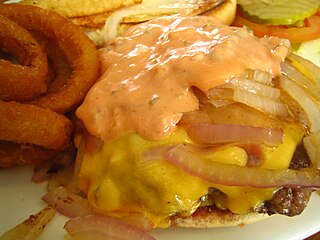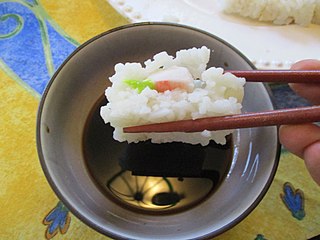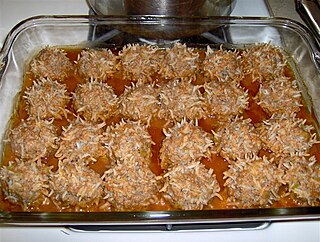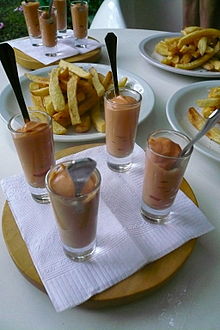
A condiment is a preparation that is added to food, typically after cooking, to impart a specific flavor, to enhance the flavor, or to complement the dish. A table condiment or table sauce is more specifically a condiment that is served separately from the food and is added to taste by the diner.

Belgian cuisine is widely varied among regions, while also reflecting the cuisines of neighbouring France, Germany and the Netherlands. It is sometimes said that Belgian food is served in the quantity of German cuisine but with the quality of French food. Outside the country, Belgium is best known for its chocolate, waffles, fries and beer.

Fry sauce is a condiment often served with French fries or tostones in many places in the world. It is usually a combination of one part tomato ketchup and two parts mayonnaise. Historically, the Argentinian salsa golf is most likely the first ketchup and mayonnaise sauce, having been invented in the 1920s by Luis Leloir.

Russian dressing is a piquant American salad dressing consisting of mayonnaise, ketchup, and other ingredients.

Rémoulade is a cold sauce. Although similar to tartar sauce, it is often more yellowish, sometimes flavored with curry, and often contains chopped pickles or piccalilli. It can also contain horseradish, paprika, anchovies, capers and a host of other items.

The milanesa is a variation of the Lombard veal Milanese, or the Austrian Wiener Schnitzel, where generic types of breaded cutlet preparations are known as a milanesa.

Chimichurri is an uncooked sauce used as an ingredient in cooking and as a table condiment for grilled meat. Found originally in Argentinian and Uruguayan cuisines, it has become widely adopted in most of Latin America. The sauce comes in green and red varieties. It is made of finely chopped flat leaf parsley, red pepper flakes, minced garlic, olive oil, oregano and vinegar or lemon juice. It is similar to Moroccan chermoula.

A dip or dip sauce is a common condiment for many types of food. Dips are used to add flavor or texture to a food, such as pita bread, dumplings, crackers, chopped raw vegetables, fruits, seafood, cubed pieces of meat and cheese, potato chips, tortilla chips, falafel, and sometimes even whole sandwiches in the case of jus. Unlike other sauces, instead of applying the sauce to the food, the food is typically placed or dipped into the sauce.

Picadillo is a traditional dish in many Latin American countries including Mexico and Cuba, as well as the Philippines. It is made with ground meat, tomatoes, and also raisins, olives, and other ingredients that vary by region. The name comes from the Spanish word picar, meaning "to mince".

The completo is a hot dog variation eaten in Chile, usually served with ingredients such as chopped tomatoes, avocados, mayonnaise, sauerkraut, salsa Americana, ají pepper and green sauce. It can be twice the size of an American hot dog.

Uruguayan cuisine is a fusion of cuisines from several European countries, especially of Mediterranean foods from Spain, Italy, Portugal and France. Other influences on the cuisine resulted from immigration from countries such as Germany and Scotland. Uruguayan gastronomy is a result of immigration, rather than local Amerindian cuisine, because of late-19th and early 20th century immigration waves of, mostly, Italians. Spanish influences are abundant: desserts like churros, flan, ensaimadas yoo (Catalan sweet bread), and alfajores were all brought from Spain. There are also all kinds of stews known as guisos or estofados, arroces, and fabada. All of the guisos and traditional pucheros (stews) are also of Spanish origin. Uruguayan preparations of fish, such as dried salt cod (bacalao), calamari, and octopus, originate from the Basque and Galician regions, and also Portugal. Due to its strong Italian tradition, all of the famous Italian pasta dishes are present in Uruguay including ravioli, lasagne, tortellini, fettuccine, and the traditional gnocchi. Although the pasta can be served with many sauces, there is one special sauce that was created by Uruguayans. Caruso sauce is a pasta sauce made from double cream, meat, onions, ham and mushrooms. It is very popular with sorrentinos and agnolotti. Additionally, there is Germanic influence in Uruguayan cuisine as well, particularly in sweet dishes. The pastries known as bizcochos are Germanic in origin: croissants, known as medialunas, are the most popular of these, and can be found in two varieties: butter- and lard-based. Also German in origin are the Berlinese known as bolas de fraile, and the rolls called piononos. The facturas were re-christened with local names given the difficult German phonology, and usually Uruguayanized by the addition of a dulce de leche filling. Even dishes like chucrut (sauerkraut) have also made it into mainstream Uruguayan dishes.

Many cuisines feature eggplant salads and appetizers.

Marie Rose sauce is a British condiment often made from a blend of tomatoes, mayonnaise, Worcestershire sauce, lemon juice and black pepper. A simpler version can be made by merely mixing tomato ketchup with mayonnaise. The sauce was popularised in the 1960s by Fanny Cradock, a British cook.

Thousand Island dressing is an American salad dressing and condiment based on mayonnaise that can include olive oil, lemon juice, orange juice, paprika, Worcestershire sauce, mustard, vinegar, cream, chili sauce, tomato purée, and ketchup or Tabasco sauce. It also typically contains finely chopped ingredients, which can include pickles, onions, bell peppers, green olives, hard-boiled egg, parsley, pimento, chives, garlic, or chopped nuts.

Porcupine meatballs are an American casserole dish of ground beef and rice meatballs cooked in tomato sauce. They were a staple during the Great Depression requiring only a few basic ingredients: ground beef, uncooked long-grain rice, onion, and canned tomato soup. The name comes from the appearance of the meatballs, which appear prickly when the rice pokes out of them as they cook, resembling a porcupine.
















